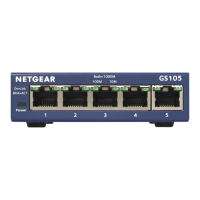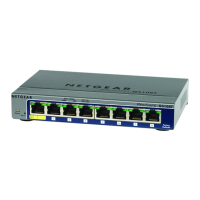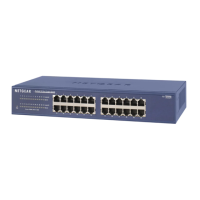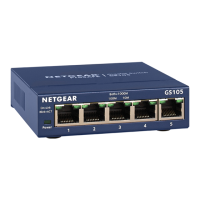Utility Commands
408
ProSAFE M7100 Managed Switches
The following is an example of the CLI command output when a ping is successful:
(Netgear Switch) #ping 10.130.135.120 count 3 size 10
Pinging 10.130.135.120 with 10 bytes of data:
Reply From 10.130.135.120: icmp_seq = 0. time= 25368 usec.
Reply From 10.130.135.120: icmp_seq = 1. time= 1543 usec.
Reply From 10.130.135.120: icmp_seq = 2. time= 1570 usec.
----10.130.135.120 PING statistics----
3 packets transmitted, 3 packets received, 0% packet loss
round-trip (msec) min/avg/max = 1/9/25
The following is an example of the CLI command output when a ping fails because the destination
is unreachable but a valid default router exists:
(Netgear Switch) #ping 10.135.64.94 count 3 size 10
Pinging 10.135.64.94 with 10 bytes of data:
----10.135.64.94 PING statistics----
3 packets transmitted, 0 packets received, 100% packet loss
round-trip (msec) min/avg/max = 0/0/0
ping ipv6
Use this command to determine whether a computer with an IPv6 address or a host name that
resolves to an IPv6 address is on the network. Ping provides a synchronous response when
initiated from the CLI and web interfaces.
Using the options described below, you can specify the number and size of echo requests, the
inter
val between echo requests, and the source.
Defaults • The default count is 1.
• The default interval is 3 seconds.
• The default size is 0 bytes.
F
ormat ping ipv6 {<ipv6-address> | <hostname>} [count <count>] [interval
<interval>] [size <datagram-size>] [source {<ipv6-address> |
<unit/slot/port> | vlan <vlan-id> | network}]
Modes Privileged EXEC
Parameter Description
count Use the count parame
ter to specify the number of ping packets (ICMPv6 echo requests)
that are sent to the destination address specified by the ipv6-address field. The range for
count is 1–15 requests.
interval Use the interval par
ame
ter to specify the time between echo requests, in seconds. Range
is 1–60 seconds.

